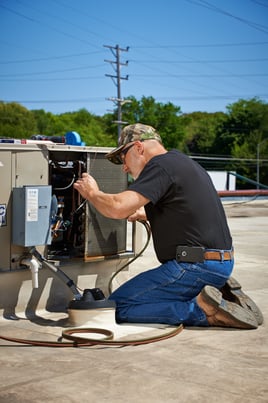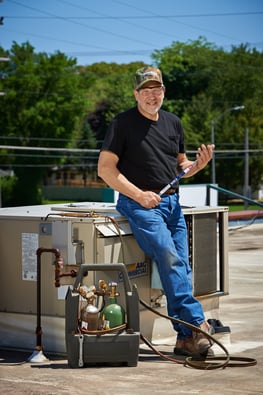what flux to use on a refrigerator compressor
Brazing Components for Refrigeration
Posted by Lucas-Milhaupt Brazing Experts on Sep 24, 2015
Brazing Components for Refrigeration Remember, brazing in the HVAC/R manufacture is much unlike from brazing in the plumbing manufacture. Solder alloy is adequate for plumbing components due to the prevalence of low-pressure h2o or fluid lines. Withal, refrigeration cycles and air conditioning systems are high-pressure, high-temperature systems requiring truthful braze alloys that are stronger than solder alloys. Alloy Selection From these four base metals, there are 5 different affix alloys: Some refrigeration joints may require joining stainless steel valves or tubing to other base of operations materials. When brazing any stainless steel components, the use of Silvaloy 505 with Handy Type B-1 flux or Ultra Black Paste Flux is recommended. Alternative filler metals are available for brazing in this manufacture, Delight contact your Technical Services representative for more data. Gas and Torch Selection Once you have selected the proper gas, choose the right torch tip before starting to affix. Each torch trunk manufacturer has a listing of recommended torch tips, based on the size of the tubes being brazed. Contact your torch body manufacturer for proper sizes. Brazing Method Nitrogen Purge Arrangement Evacuation and Charge Conclusion: This article is Role 2 of a ii-part series on brazing for refrigeration. See Office 1: Brazing for the Refrigeration Cycle for the basic processes within a refrigeration organisation. As an additional resource, our video on Brazing Copper to Copper will walk you through the brazing process. For repairing aluminum joints, please see our video on Aluminum HVAC/R repair. We are pleased to provide practiced information for Global Brazing Solutions®. Experience free to share this posting with assembly, and save our web log site to your Favorites for easy reference. Questions nigh brazing? Contact us for farther help. For more than information on HVAC/R brazing, encounter our blogs and website. For detailed questions regarding specific applications, please telephone call Lucas Milhaupt's Technical Department at 800.558.3856.
Today, nosotros address correct brazing alloys as well every bit proper brazing methods for refrigeration components. Our main topics are:
The HVAC/R industry uses these four common base materials:

Subsequently determining which alloy to use for your application, the next step is selecting the correct gas and torch type. At that place are 4 main gasses used in the HVAC/R industry for brazing:

After selecting the right gas and torch blazon, information technology is fourth dimension to braze. Recall these central steps to producing a leak-proof, quality joint:
When brazing in HVAC/R, continue the inside of the tube complimentary of oxidation by purging the system with nitrogen. Nitrogen acts every bit a cover gas to prevent surface oxidation inside of the tubes. Note that the industry's move toward polyolester oil (or POE oil), requires purging with nitrogen during brazing. POE oil is very hygroscopic (h2o loving) and reacts with residual moisture in the system if not purged with nitrogen.
In one case brazing is complete, and you have removed flux residue from parts, the adjacent step is checking for leaks in the organization. To ensure that moisture is vacated, the lines must have an evacuation to 500 microns, measured with a micron gauge. If you cannot evacuate the system to 500 microns, this may point a leak. Finally, charge the system with the required refrigerant per customer or manufacture specification.
In summary, choosing the correct brazing alloy and flux, the correct torch and gas, and and then post-obit the proper brazing methods helps you produce leak-proof, quality HVAC/R joints. Following manufacture-specific practices of purging, then charging the system to the correct pressure, prevents contagion and articulation failure.
Topics: HVAC/R, Copper, Steel, Aluminum, Torch
Source: https://blog.lucasmilhaupt.com/en-us/about/blog/brazing-components-refrigeration
0 Response to "what flux to use on a refrigerator compressor"
Post a Comment